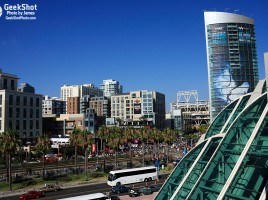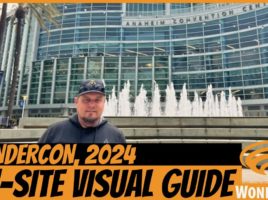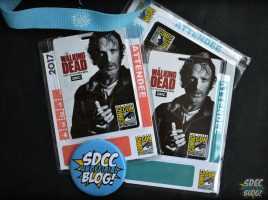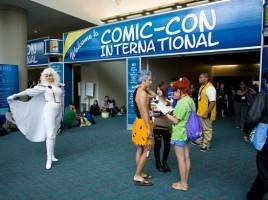One of the things that has become a part of Comic-Con as much as the long lines and cool exclusives is photos. People with everything from cameraphones, point and shoots, starter DLSRs, all the way up to professional gear. I’m guessing those with the professional gear know what they’re doing, so this blog is for the rest of us.
First off, let’s talk about the camera types. Phones with cameras are usually the least quality and have the fewest options. They aren’t much use during panels unless you can shoot video. Point and shoot cameras come in a variety of types, from the $100 pocket camera to the $500 super-zoom. P&S cameras have options, but how many depends on the price, and you can’t change the lens. DSLR (Digital Single-Lens Reflex) cameras used to be for the pros, but they are cheap enough for most these days. DSLRs have multiple modes from fully automatic to fully manual and have interchangeable lenses.
But which camera to choose? I could write a whole blog just on that subject. The simple answer is 1) How much money do you want to spend, and 2) What are you going to shoot? Just like most things in life, the more you spend, the better the product. I will say that once you are looking at spending up to $500 on a super-zoom or high end point and shoot, shift over and check out the lower priced DSLRs. You will get more for your money.
Now on to actual photo tips. After asking for what you wanted to have me write about on Twitter, I have a good idea what to talk about. We’re going to at least mention all of the following: accessories, panel settings, show floor settings and the best places to shoot inside and outside the con.
Before I get to specific settings, let me go over something most people miss: white balance. Every camera has it and most people never use it and just leave it on auto. This works most of the time. If you are ever getting a photo that looks off, too blue outdoors or too red indoors, take some time to change the white balance setting. Take a shot or 2 as a test before a panel on different settings and see what happens. If you are ever unsure, just leave it on auto. Another thing to mention is for those cameras that can shoot in RAW format. White balance and a few other settings can be changed in RAW even after the fact. It will take up a lot more room on your memory card, but you’ll have a lot more editing freedom when you get home.
Accessories
The first thing most people wonder about is a tripod. When you’re sitting in a panel and taking photos without one, your arm gets tired or your shots are blurry. The problem is that most tripods are big, bulky and heavy. If you plan to camp out in a panel room all day every day, this won’t be a problem and a tripod would be a good buy. There are two other options, though. A monopod is the best compromise for steady shots and ease of use. You won’t have to bother people around you with the legs or have something bulky in your bag. Most weigh up to 2 pounds and condense down to 20 inches or less. A monopod will also make low light and night shots a lot easier. Another option for those with lighter cameras (under 3 pounds) is a fold-up tripod like this. It’s not as sturdy as a regular tripod, but it’s light, compact, and will get the job done.
Panel Settings
This is the most common question I got asked. How do I get better shots during a panel? The first thing you have to do is check out everything you can change on your camera. For those with DSLRs, everything is adjustable. For those with P&S cameras it may be anywhere from very little to everything.
The best thing you can do for better panel shots is to make sure your shutter speed is fast enough to freeze the panelists. This means 1/100 of a second or faster, with 1/250th as your target speed. Faster is always better.
The problem is, when you speed up the shutter, you let in less light and your photos are dark. So you have to adjust either the aperture or the ISO. On most P&S cameras, you can only adjust the ISO, so let’s talk about that. A lot of people don’t know what ISO is and just set it to auto. ISO is essentially how fast your camera processor takes the available light to generate a photo. Low ISO equals more processing, which equals longer time needed, which equals better looking photo (less grain). So upping the ISO means you will get a grainier photo but you will need less shutter time to get it. ISO is probably the only setting you can change to help you get a less blurry shot when nothing else will work. Especially when you’ve already lowered your aperture as far as it will go. Yes, your photo will have more grain in it, but you will have something to work with instead of a bunch of blur.
Aperture (the f-stop) is a lot easier to figure out for panel settings. Whatever your lowest setting is, make it so. On most P&S cameras, there is no way to change aperture itself, but you may have themed settings such as “sport” or “night scene”. If that is the case, sport or any other setting that is for fast shutter/low light should work. Do some tests at home with the different settings to see which will be best for you.
DLSR owners have the bonus of being able to switch lenses. What this will allow you to do is get a lens specifically for panels. If you want to spend the money, a 70-200mm f2.8 lens will do wonders for low light photos. If you have to get something less expensive, go for one of the 70(or 75)-300mm lenses. These will be higher aperture, and you’ll have to raise the ISO and/or lower the shutter speed, but you’ll be able to get better close-ups of the panel guests. If you want a lens that you never have to change, check out the 18-200mm ones. Both Canon and Nikon make one, but be warned that they do have drawbacks. Check out online reviews to see if the pros outweigh the cons.
If you’re going to shoot with a DLSR, I recommend figuring out your settings and going full manual. While the new cameras are very smart, they can sometimes mess up on semi or full auto. If you have one of the regular zoom lenses I mentioned above, you’ll have f5.6 as your lowest aperture when fully extended. Depending on your camera, your ISO will top out at 1600 or 3200 (6400 on mid-range cameras), and will also look very grainy at those settings. I try to always stay one setting below the max ISO whenever possible. The photos below are examples of both Ballroom 20 (Jim Parsons) and Hall H (Olivia Wilde).
On each of these my settings were 1/100th shutter, f5.6 aperture, ISO 400 and 250mm using the 55-250mm Canon lens and a Rebel XSi. I was in the front row for each photo, which is why I was able to get such close shots. As you can see, Ballroom 20 came out better; brighter and less grain than the Hall H photo due to more light and a white background. I also edited these to get them to look this way. The originals were darker and I increased the brightness in post-processing. If you do this, be careful that you don’t let the photo get too dark, or you’ll have a lot of grain and less detail. One thing to be aware of is that black and white is much more forgiving when this happens, so don’t be afraid to try that out for darker photos.
Finally, the use of flash at panels. Personally, I don’t like using flash 99% of the time. It not only makes most photos look washed out, but it bothers the panel guests. It also is ineffective for most cameras unless you’re within 25 feet of the subject. If you are within range, and feel like using it, set your ISO at 400 and (if you can) your aperture around f8. This should help the flash fill as much of what you want to capture as possible.
Show Floor/Outdoor Settings
The con floor is an odd lighting area. There is light everywhere, but it’s just not quite enough to get photos easily. Whenever I shoot on the floor, I put ISO at 400 and put my camera on aperture priority and set it as low as possible (f3.5 on my kit lens, 18-55mm). This lets the camera choose the shutter speed. Usually I can get a shot I like, but there is always the chance the shutter will be too slow and I’ll get something blurry. The easiest way to combat this is to up the ISO more, or revert to a scenes mode like I mentioned for the panels. The higher end cameras will look better at higher ISO, so this won’t be a problem for those. For most P&S cameras, this will cause noisy/grainy photos. The other way to combat this is with a flash, but again, this tends to wash out your subject. No matter what you choose, make sure you get that shutter speed fast enough. I’ve kicked myself many times when a shot of a cosplayer is too blurry to use because I was too stubborn to up my ISO one more level or use flash.
When you are outside, a lot of these concerns go away and others come into play. Sunlight is harsh except in the early morning and late afternoon/evening. I suggest setting your ISO down to 100 and putting your aperture around f8-11 for most shots. These are typical outdoor/generic settings. If you know about bokeh and the depth of field effect of aperture, then you’ll know when to change your aperture for them. If there are shadows falling on your subject and you can’t move away from them, the best thing to do is turn on your flash. This will fill in the shadow areas while keeping the rest of the shot as it was. You may need to increase ISO to extend the reach of your flash. If you have problems getting a good shot this way, you might need to spend a few minutes playing with the settings, or just put the camera on full auto.
Where to get the “best” photos
This is not an easy one to answer. How many times have you been wandering the con and happened across a split second moment of awesome? How many times have you seen someone else’s photo of a great moment and wished you could have been there? The sad truth is that you won’t be able to get every awesome moment, or even most of them. You can just be prepared for those moments when they happen. Most cameras have a power save feature. I always keep my camera on and let it go to sleep. It might only be a split second faster to start up, but you never know when that can make the difference between getting the shot or not.
For the last few years, I have been either working behind the table at the Browncoats booth, or attending panels, so I don’t have much first-hand knowledge of where to go for photos. I do know for cosplay shots there are two good areas to hang out (if you know more, let us know in the comments). The stairs in front of the con between hall C and D, and the mezzanine level, both outside and inside near the fan group tables, in the back of the convention center seem to attract a lot of people in costume. Keep an eye out for announced group photo shoots, such as the Avengers Initiative Friday morning at 11 AM on the back steps behind the Mezzanine Level. You should also pay attention to when companies announce a contest or other gathering at their booth. I’ve seen both Marvel and Dark Horse post announcements this week.
You can try to get shots of actors on the show floor if you miss the panels. A significant number of them now do signings at the studio booth for their show/movie. Most of the time security tries to keep you moving, so you have to plan ahead. Keep moving when you aren’t taking a shot, and don’t take too long when you are stopped. Or find a good spot with line of sight, but out of a walking area. It takes a lot of patience, a quick shutter finger and the willingness to fight the crowds to get these photos.
I hope something I’ve gone over will help you get the photos you want during the convention. If you have any specific questions, feel free to ask me on Twitter, Facebook or in the comments below. I’ll try and answer everything I see before Comic-Con starts. I may even be able to answer some stuff while waiting in line during the con.
Best of luck on getting those photos!
UPDATE: There are more good tips in the comments. Feel free to share more or ask questions.








